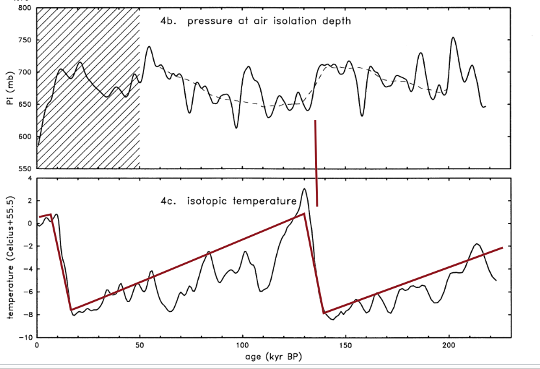
Thanks Josh cartoonsbyjosh.com
The main prediction from the caterpillar theory of plate tectonics is that we should see changes in volcanic emissions resulting in changes to the atmosphere such as increasing CO2 & pressure.
The Caterpillar theory is that thermal expansion during the ice-age leads to one plate of the crust being pushed under another. It then cools pulling out from the mid ocean ridges and so tends to move like some caterpillars.
There is strong evidence that the ice-age cycles affect mid oceanic ridge formation and the rise of CO2 as the crust warms is also supportive evidence for this theory (although hardly conclusive as we also expect outgassing).
In my last couple of posts (overview, calculations), I speculated that global pressure had been changing significantly in recent geological times and that possibly if the air pressure increased by 30% that would be enough on its own to cause the 8C warming we see coming out of an ice age.
How can we prove a change in pressure?
I thought about looking for a correlation with some physiological aspect of bird – because surely they need “thick” air more than any other creature? All I found was that birds fly well above Everest and that there does not appear to be much of a limit in terms of air pressure. That in itself may be evidence that the earth’s pressure has been lower and we now have birds adapted for much lower air pressure – but that is just speculation.
I thought about possible geological signatures from the change in boiling point of water from 100C to around 90C. But there are few places where we see natural boiling water exposed to the air today – so there’s a very slim chance useful changes have been recorded.
Another possibility is that dissolved gas content will change in water. I’ve looked for research into high altitude water to see whether there are any changes which might be recorded in some way – but so far I’ve not found anything.
The evidence I need ??
Finally, I found what appeared to be exactly what I wanted from this paper:
Air content paleo record in the Vostok ice core (Antartica): A mixed record of climate & glaciological parameters Martinerie et al
The graph below shows a proxy for air pressure at the top, with an average that rises and falls, and the sharp “rise” exactly matches the sharp rise in temperature coming out of the last but one ice-age.

Graph showing estimate of pressure at ice surface (top) & temperature(Bottom) over last 230,000 years from Vostok ice core
Except I was reading the upper plot right to left and lower left to right. (it’s easier to make this mistake when they are separated!) Far from showing air pressure rising when there is the dramatic warming at the end of the ice age, the air pressure actually seems to fall.
Search for the dog that ate the pressure
Of course, like climate academics facing the pause, looking for the dog that ate the heat (homework), I immediately started looking for excuses. And so I found that this was not actually air pressure. Instead it was volume of air trapped in the ice each volume of ice. There was an implicit assumption by the authors that the same number of voids were forming and only the pressure in the air was changing.
However, let’s be honest, if it had shown rising pressure I would have cited it as evidence that the ice melted due to rising pressure. But so would they! And probably we’d already be saying that the ice-ages ended when pressure rose.
What I think this shows is that when the ice is warmer, the surface layer of moisture in some way tends to peculate down to fill in the voids in the ice so that there is less air trapped during warmer periods (I never handed homework in on time!) – which if one then assumes the same space for air, leads to the conclusion that air pressure reduces during warm periods.
One good outcome
This does explain why rising air pressure has never been previously considered.
One bad outcome
This result is explainable but is generally against the idea that rising pressure caused the warming at the end of the ice age. Therefore this raises the hurdle: that I would now need to find not something that “hinted” at rising pressure, but something fairly concrete or perhaps numerous sources to have “supportive evidence”.
Explanation of title.
I am constantly seeing more and more evidence that the “wheels are falling off the global warming bandwagon”. And I just thought a caterpillar with wheels was amusing.


Plate tectonics affected by air pressure and air temperature – is this an April fools joke?
Thanks Dave.
If you consider it, there is nothing I’m suggesting that is not (in theory) supported by very well known science:-
The crust heats in response to changes in surface temperature (true). That causes expansion (true). That in turn causes subduction (this must happen). Subduction will push down rocks causing them to be heated and thermally decomposed (a given).
That heating of the crust causes significant amounts of gas. It will cause some, whether it is significant is still a hypothesis, although the crust certainly responds to the ice-age cycle as we see the tell tale effects of differential movement at the mid ocean ridge. So a hypothesis with supportive evidence. (see: Caterpillar theory summary)
That pressure increase leads to higher temperature – (PV=nRT) – seems to be “just science”. So, it is just the application of well known scientific rules that pressure increase will increase atmospheric temperature and this will in turn affect plate tectonics.
However … the hypothesis that:
pressure increase will significantly increase temperature and significantly affect plate tectonics and then in turn affect atmospheric pressure … is still a hypothesis.
Please, see this paper for the latest pressure-temperature relationship on a planetary scale:
https://tallbloke.files.wordpress.com/2015/09/planetary_temperature_model_volokin_rellez_2015.pdf